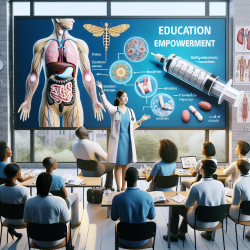Introduction
In the realm of speech-language pathology, particularly in online therapy services like those provided by TinyEYE, the integration of data-driven decisions is crucial. The research article "Linkages of Acute Care and Emergency Medical Services to State and Local Public Health Programs: The Role of Interactive Information Systems for Responding to Events Resulting in Mass Injury" provides valuable insights that can be applied to enhance the effectiveness of online therapy services. This blog post explores how practitioners can leverage these insights to improve outcomes for children receiving online therapy.
Key Insights from the Research
The research highlights the importance of interoperability and interactive information systems in managing public health emergencies. While the context is different, the underlying principles can be applied to online therapy services:
- Interoperability: Just as emergency services require seamless communication across different agencies, online therapy platforms should ensure interoperability between various tools and systems used by therapists, schools, and families.
- Data-Driven Decisions: The research emphasizes the use of data to inform decisions during emergencies. Similarly, online therapy services can benefit from data analytics to tailor interventions and track progress effectively.
- Real-Time Communication: The need for real-time information exchange is critical in emergency response. In online therapy, real-time communication between therapists and families can enhance engagement and therapy outcomes.
Implementing Research Insights in Online Therapy
Practitioners can enhance their skills and improve therapy outcomes by implementing the following strategies:
- Utilize Interoperable Tools: Ensure that the online therapy platform integrates seamlessly with other educational and communication tools used by schools and families. This integration facilitates a holistic approach to therapy.
- Leverage Data Analytics: Use data analytics to assess the effectiveness of therapy sessions. By analyzing data trends, therapists can adjust their strategies to better meet the needs of each child.
- Enhance Communication: Foster open lines of communication with families and schools. Regular updates and feedback loops can help align therapy goals with the child's educational and developmental needs.
Encouraging Further Research
While the current research provides a foundation, there is a need for further studies specifically focused on the application of these principles in online therapy settings. Practitioners are encouraged to engage in research initiatives that explore the impact of interoperability and data-driven decisions on therapy outcomes.
Conclusion
By drawing parallels between emergency response systems and online therapy services, practitioners can enhance their approach to delivering therapy. The integration of interoperable systems, data-driven decisions, and real-time communication can significantly improve outcomes for children receiving online therapy.
To read the original research paper, please follow this link: Linkages of acute care and emergency medical services to state and local public health programs: the role of interactive information systems for responding to events resulting in mass injury?










